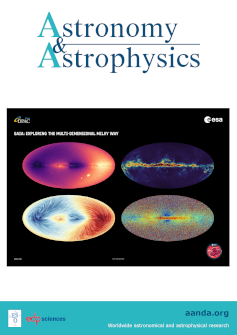Post-common envelope evolution of helium-core white dwarfs⋆
IF 5.4
2区 物理与天体物理
Q1 ASTRONOMY & ASTROPHYSICS
引用次数: 0
Abstract
Context. Helium-core white dwarfs (He WDs) from the common envelope (CE) channel offer insights into binary evolution and compact remnant formation. Their cooling rates influence their detectability and affect age estimates of close binaries. Compared with those from stable Roche-lobe overflow (SRLOF), CE He WDs experience a distinct mass-loss history, leading to fundamental differences in the post-CE evolution of the resulting WDs.Aims. We investigate how the H-envelope mass (MH) affects the cooling evolution of CE He WDs. In particular, we analyze how the bifurcation point, which separates the degenerate He core from the envelope, determines the remaining MH and the presence of residual H burning.Methods. We computed evolutionary sequences for He WDs of 0.20 M⊙ to 0.42 M⊙, from a 1 M⊙ progenitor on the red giant branch. Using the La Plata stellar evolution code (LPCODE), we followed their evolution from the post-CE phase to the cooling track, identifying two pathways depending on the remaining H: (i) non-flashing sequences, in which WDs cool without prior nuclear burning, and (ii) flashing sequences, in which H shell flashes reshape the envelope before cooling.Results. CE He WDs with minimal MH cool rapidly after formation, with negligible residual H burning. For a sample with Teff between 12 000 and 27 000 K, our models predict ages of 5–130 Myr, increasing to slightly above 300 Myr for Teff<10 000 K, which is much younger than those from SRLOF sequences. In contrast, WDs with more MH sustain residual nuclear burning, delaying cooling. At Teff<10 000 K, these models predict ages of several Gyr, far exceeding those from SRLOF and minimal-envelope sequences. Flashing sequences significantly extend the pre-WD phase compared to non-flashing sequences, but this phase remains much shorter than in SRLOF evolution. The amount of MH also affects mass and surface gravity estimates, introducing systematic differences from SRLOF WDs at a given Teff.Conclusions. The evolutionary paths of CE He WDs differ significantly from those of SRLOF-produced WDs. Minimal-envelope CE WDs cool rapidly and merge at lower temperatures, while those with sustained H burning remain bright for longer and merge at higher temperatures. These differences with SRLOF WDs are critical for understanding the evolutionary history and final fate of He WDs in compact binaries.氦核白矮星的后普通包层演化
上下文。来自共同包层(CE)通道的氦核白矮星(He WDs)提供了对双星演化和致密遗迹形成的见解。它们的冷却速度影响它们的可探测性,并影响对近距离双星的年龄估计。与稳定罗氏叶溢出(SRLOF)相比,CE - He WDs经历了不同的质量损失历史,导致其后CE演化的根本差异。我们研究了h包层质量(MH)如何影响CE He WDs的冷却演化。特别地,我们分析了将简并氦核与包络分离的分岔点如何决定剩余氢和残余氢燃烧的存在。我们计算了从红巨星分支上的1 M⊙祖先的0.20 M⊙到0.42 M⊙的He WDs的进化序列。使用La Plata恒星演化代码(LPCODE),我们跟踪了它们从ce后阶段到冷却轨道的演化,根据剩余的H确定了两条路径:(i)非闪烁序列,其中WDs在没有事先核燃烧的情况下冷却,以及(ii)闪烁序列,其中H壳在冷却前重塑包膜。具有最小MH的CE和WDs在形成后迅速冷却,残余H燃烧可以忽略不计。对于在12,000和27,000 K之间的TeffMH样品,我们的模型预测年龄为5-130 Myr,对于TeffMH持续残余核燃烧,延迟冷却,年龄增加到略高于300 Myr。TeffMH也会影响质量和表面重力估计,在给定的teffh上引入与SRLOF WDs的系统差异。CE - He WDs的进化路径与srlof产生的WDs有显著差异。最小包壳CE发光二极管迅速冷却并在较低温度下合并,而持续H燃烧的发光二极管保持较长时间的亮度并在较高温度下合并。这些与SRLOF WDs的差异对于理解致密双星中He WDs的进化历史和最终命运至关重要。
本文章由计算机程序翻译,如有差异,请以英文原文为准。
求助全文
约1分钟内获得全文
求助全文
来源期刊

Astronomy & Astrophysics
地学天文-天文与天体物理
CiteScore
10.20
自引率
27.70%
发文量
2105
审稿时长
1-2 weeks
期刊介绍:
Astronomy & Astrophysics is an international Journal that publishes papers on all aspects of astronomy and astrophysics (theoretical, observational, and instrumental) independently of the techniques used to obtain the results.
 求助内容:
求助内容: 应助结果提醒方式:
应助结果提醒方式:


